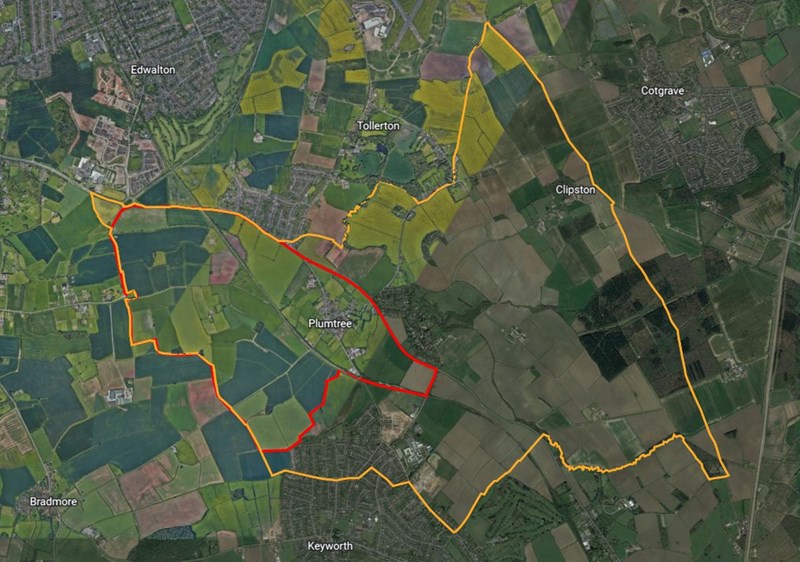A Brief History of Plumtree
Plumtree's population has remained fairly constant during its transition from an agricultural village to a residential one. At the beginning of the 20th century, the village was predominantly an agricultural community with 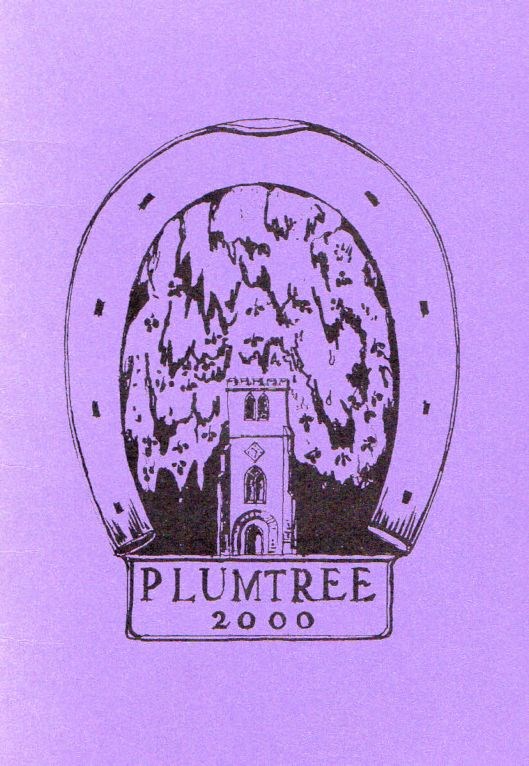 mixed farms (i.e. having both crops and livestock). In addition to the farmers and agricultural labourers there were tradesmen such as the blacksmith, miller, saddler, butcher and carter, a lot of whose work was agriculture-related. They lived and worked within the village and many of their homes and the farm buildings remain today.
mixed farms (i.e. having both crops and livestock). In addition to the farmers and agricultural labourers there were tradesmen such as the blacksmith, miller, saddler, butcher and carter, a lot of whose work was agriculture-related. They lived and worked within the village and many of their homes and the farm buildings remain today.
Most of the following information is based on the booklet "Plumtree 2000" which was produced by Plumtree villagers and members of the Keyworth and District Local History Society for the 2000 Millennium celebrations. We would like to acknowledge the hard work performed by Sheila Leeds who created this booklet. We have updated some of the text to reflect recent changes in the village and amended the formatting to be more suitable for website presentation.
You can read more about Plumtree's history using the following links:
- Plumtree's First Parish Council including a photograph and the minutes of Plumtree's first Parish Council meeting, held in 1977.
- The Phone Box, now a book-lending facility.
- Village Sunday Morning an account of a Sunday morning service held in Plumtree Church that was printed in the Nottingham Journal in 1905.
Click on a button below to display further details. Use your browser's Back button to return here.
Plumtree 2000 (updated)
An introduction to Plumtree
Plumtree is a small village, situated about 5 miles (8 km) south east of Nottingham. The ecclesiastical parish of Plumtree also includes Normanton-on-the-Wolds, Clipston-on-the-Wolds, Plumtree Park and North Keyworth. The village is bordered by several other villages, namely, Edwalton, Tollerton, Stanton-on-the-Wolds, Keyworth, Bradmore and Ruddington. Unlike some of its neighbours, Plumtree's population today is about the same as it was 200 years ago.
The old parish was shaped rather like a butterfly, with the main part of the village as the 'body' with a wing on each side. However in 1987 drastic changes were made to boundaries and Plumtree lost most of its eastern 'wing' and gained a small part of Normanton in exchange. The end result was that Plumtree station, although disused, is now in Plumtree not Normanton, Plumtree Wolds are now in Normanton and Plumtree Park is in Keyworth.
In this image the line in red shows the Plumtree Parish Council Boundary; the line in orange shows the Plumtree Church Parish boundary
At one time Plumtree had three large fields with villagers farming strips or 'lands' in several different places. In 1807 the village was 'enclosed'. After that the land was divided into three main sections, land belonging to the two 'Lords of the Manor' (W. E. Elliott and J. Elliott), and land for the Rector for tithes and glebe. These fairly large parcels of land were then divided into smaller fields. Since that time some of the small fields have been rejoined to make larger areas, more suitable for today's farming methods.
Geologically, most of Plumtree is on Keuper Marl, with a small area of sand and gravel near the railway. On the eastern side is an area of limestone, some of which can be seen in the church wall and other local walls.
Through the centuries many people have lived in Plumtree; some families have stayed for three or more generations. The two outstanding examples are the Astills who are first recorded in the 1621 baptism register, and the Murdens who are first recorded in the 1731 burial register. Other family names which appear in records for long periods are Alcock, Bexon, Bradley, Chapman, Cluro, Craft, Hallam, Hickling, Holmes, Hubbard, Linaker, Lowe, Pearson, Squire, Stephenson and Turner. In the last century the families of Richmond, Elding and Cockayne lived here for many years.
Communications
At one time Plumtree was a stopping place on the route of the Leeds to London Mail Coach. After leaving Nottingham the coach would drive to Plumtree and the horses would be changed at the Farmers Arms ready for the next stage to Melton Mowbray.
In 1812 local newspapers reported an accident, when a wagon loaded with barley was in collision with a gig. Unfortunately the horse took fright and trampled the wagon driver to death.
From 1878 the the main road was run by the Nottingham, Melton and Kettering Turnpike Trust; there was a toll gate at Lings Bar and another in the village. In 1867 the Surveyor reported: "Many parts of the Turnpike are in a sad state and that there wants much more material putting on immediately in Plumtree and Broughton parishes." A letter of 1868 complains about someone "...allowing his cattle to stray and graze on the Melton Turnpike Road".
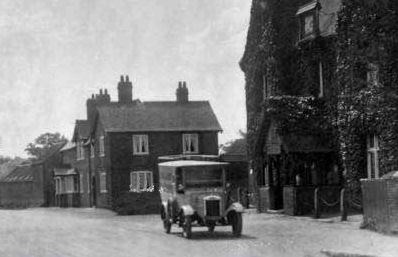 The 19th century directories show that carriers would deliver goods from Nottingham to the village. In 1814 the carrier to Plumtree was W. Astill who was to be found "near the fish stalls, Market Place Nottingham" on Saturday at 3pm. In 1869 it was stated that George Linney's van passes through Plumtree on its way from Upper Broughton to Nottingham on Monday, Wednesday and Saturday.
The 19th century directories show that carriers would deliver goods from Nottingham to the village. In 1814 the carrier to Plumtree was W. Astill who was to be found "near the fish stalls, Market Place Nottingham" on Saturday at 3pm. In 1869 it was stated that George Linney's van passes through Plumtree on its way from Upper Broughton to Nottingham on Monday, Wednesday and Saturday.
By the 1920s the volume of traffic was causing concern and in 1930 a bypass was built. Although this does take through traffic out of the village, the road through Plumtree is still very busy as it forms the main access from Nottingham to the town of Keyworth, which has grown rapidly in size in the past 30 years.
Other roads provide links to the neighbouring villages: Bradmore Lane to the west, and Church Hill which leads to Normanton and Clipston. Within the village, Church Lane makes a short detour round The Green. Bradleys Yard, Fellows Yard and Saddlers Yard are recent additions which give access to new houses. Mill Lane, once the route to Flawford Church, is now a bridleway.
The Nottingham to Melton Mowbray branch of the Midland Railway was opened in 1880 with a station between Plumtree and Keyworth. There were passenger services on the line from 1880 until they were discontinued in 1949. Goods traffic lasted a little longer, until 1965. After the station closed part of it was rented, in 1962, by the Nottingham Trolleybus Group who hoped to use it to restore vehicles for public display. Unfortunately by 1974 this had to close. In 1982 the remaining station buildings were converted into a restaurant.
Plumtree telephone exchange was opened next to the school in 1958. It also serves Tollerton and Keyworth both of which have a much larger number of inhabitants than Plumtree.
St Mary's Church
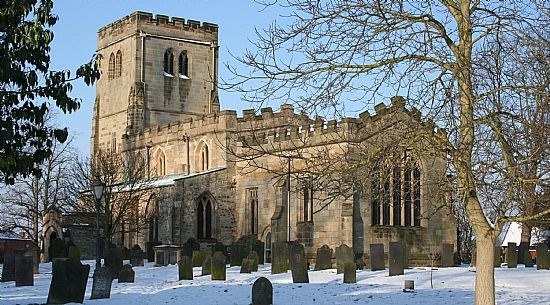 St Mary's church is believed to be the oldest parish church in the county and has an unconfirmed foundation date of 837 AD. The Domesday Book of 1086 certainly mentions a church at Plumtree.
St Mary's church is believed to be the oldest parish church in the county and has an unconfirmed foundation date of 837 AD. The Domesday Book of 1086 certainly mentions a church at Plumtree.
The church stands on a small hill on the east side of the village.
At first sight it appears to be just an ordinary little village church. However, closer to, a beautifully decorated Norman doorway can be seen in the west wall of the tower.
This is not the oldest feature though; hidden beneath the tower is some Saxon masonry. Much of the structure is Early English (from the 13th and 14th centuries).
The north wall contains stones from the old Trent Bridge which was demolished in the 1870s.
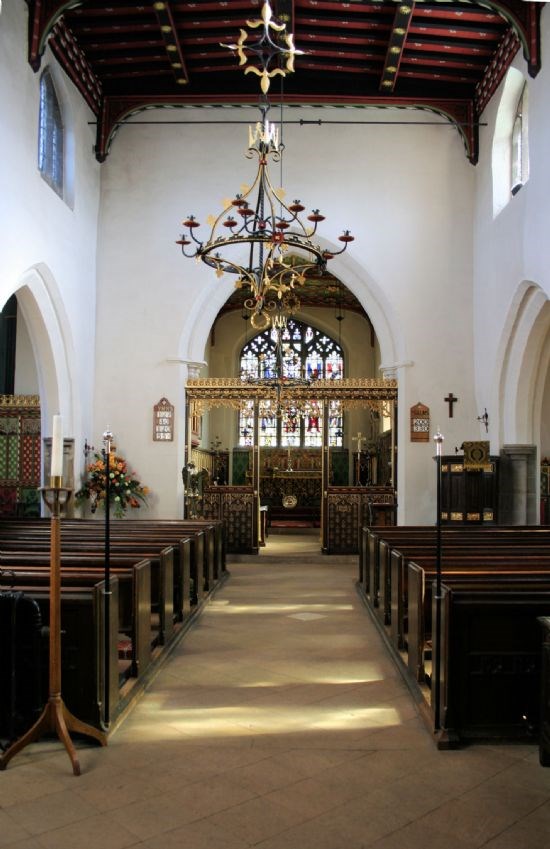 It's on entering the church that the real surprise comes. In the late 19th century the interior was redesigned and decorated by Bodley & Garner. About a hundred years later their work was restored, leaving the beautiful sight we see today.
It's on entering the church that the real surprise comes. In the late 19th century the interior was redesigned and decorated by Bodley & Garner. About a hundred years later their work was restored, leaving the beautiful sight we see today.
The church was originally lit by candles and special candelabra were made by Thomas Coldron, the village blacksmith at Brant Broughton in Lincolnshire.
On the south wall of the chancel are a triple stone sedilia (seats that were provided for the priest who celebrated mass, and for the deacon and sub-deacon who assisted him) and a piscina (a shallow basin formerly used for washing the communion vessels) of very early date. Nearby is a memorial to Revd Vere Harcourt, Rector of Plumtree and Archdeacon of Nottingham, who died in 1683.
Many of the fittings in the church were gifts from the Burnside family. These include the organ, the lectern, the prayer desk, and the original church clock (now replaced by an electrical movement), as well as some of the stained glass windows.
In the 16th century three bells hung in the church tower. These were replaced in the 1620s and served for over three hundred years. They were then moved to other churches in the diocese when a set of six bells was purchased from St Mary's church in Clifton, retuned and installed in 1992. In 2010 two extra bells were added making a 'peal' of eight.
The church has been a focal point for the village for a very long time and continues to provide a venue not just for the regular services but for special occasions such as Flower Festivals.
As well as being open for regular services, the church is frequently open to visitors. You can browse around at your own pace and use the detailed information sheets to learn more about the church and its churchyard. For £1 you can purchase a colourful church guide.
Plumtree School
Plumtree School stands at the crossroads in the centre of the village. A plaque on the wall bears the inscription "Plumtree School, erected by W. E. Elliott Esq. A.D. 1840". It is thought that, prior to this, there could have been a school of some sort in the village as the 1832 directory mentions: "S Parr, schoolmaster", but it is not clear where this was. However Samuel Parr is listed as schoolmaster in the 1851 census returns, so he could have held that office when the new building opened.
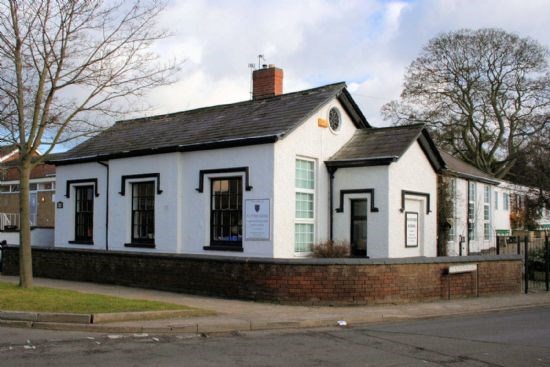
The earliest school Log Book begins in 1871 and contains some interesting entries which reflect the life in the village at the time.
23rd August 1871
A diminution in the attendance in consequence of the approaching harvest.
2nd October 1871
Several absentees it being Nottingham Fair (Goose Fair).
18th - 22nd December 1871
No school this week in consequence of the prevalence of smallpox and scarlet fever.
A few years later education was still not receiving full attention from the villagers and the headteacher is clearly rather cross!
25th April 1879
Many children have been absent this week working on the farms and 'tending cows' in the lanes. The farmers gladly employ the children and the parents are anxious for their children to earn something. I have spoken to many parents about the wrong they do in not sending their children to school - but present gain outweighs all future good.
Even without financial gain children could miss school.
21st May 1879
The attendance at school is very thin several children are absent gathering cowslips which are very plentiful this year.
A later log book notes evacuees who were sent to the village. In some cases their stay was short as they found it difficult to adjust to the quiet country life and missed their homes and families.
In 1904 the school was extended and, in the years that followed, other changes and repairs were carried out. In 1951 it became a Church of England Controlled School, which it remained until it was closed in 1974. Since then the village children go to school in Keyworth.
Nowadays, Plumtree School is an Independent School with children coming from the surrounding area rather than from Plumtree village.
The Rectors of Plumtree
The North wall of the church has a complete list of the Rectors of Plumtree, beginning with Roger de Sylly in 1251. Some Rectors only stayed for a short time while several had very long incumbencies. The church and churchyard contains memorials to some of them.
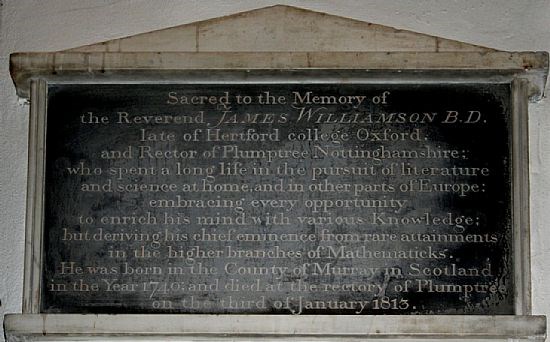 Inside the church, on the south wall, there is a monument to Revd James Williamson who died in 1813. It states that, in addition to his duties as Rector, he "...spent a long life in the pursuit of literature and science at home and in other parts of Europe: embracing every opportunity to fill his mind with various knowledge; but deriving his chief eminence from rare attainments in the higher branches of mathematicks".
Inside the church, on the south wall, there is a monument to Revd James Williamson who died in 1813. It states that, in addition to his duties as Rector, he "...spent a long life in the pursuit of literature and science at home and in other parts of Europe: embracing every opportunity to fill his mind with various knowledge; but deriving his chief eminence from rare attainments in the higher branches of mathematicks".
Plumtree Rectory stands next to the church separated by a low wall. It has always been a large building: the Hearth Tax entry of 1674 shows it as having 10 hearths, making it one of the three largest rectories in the county at that time.
It stands in about five acres of land. Some of this has been used for gardens which lead down to a ha-ha or sunken wall, allowing a clear view of the fields beyond. There is also a small area of parkland.
In 1809 the house had a barn, stable, cow house and pig sty, yards and garden.
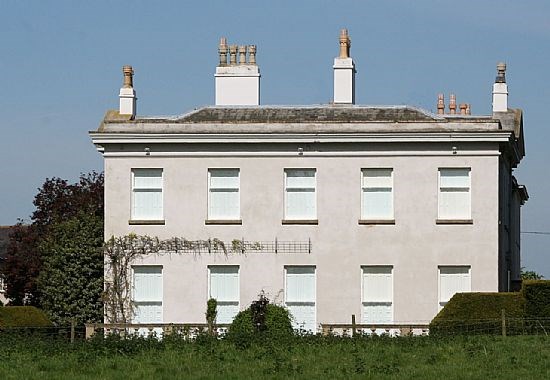 The house was enlarged and rebuilt in 1816 by John Burnside, the Rector at that time. Today it is a Grade II listed building and has recently had considerable restoration. It is Late Georgian in style, with a very imposing entrance with columns supporting a central triangular pediment.
The house was enlarged and rebuilt in 1816 by John Burnside, the Rector at that time. Today it is a Grade II listed building and has recently had considerable restoration. It is Late Georgian in style, with a very imposing entrance with columns supporting a central triangular pediment.
Inside, the rooms are spacious and their names, as quoted in a recent sale catalogue, give an impression of their size - for example - Reception Hall, Billiard Room, Vaulted Cellars, Tack Room, Game Larder. There is a fine cut-string staircase which leads to the first floor where there are nine bedrooms.
The separate Coach House has been completely renovated and restored, and won a design award.
The last Rector to live in the Rectory was Revd Harold Robinson. In 1936 it was sold and few years later a smaller Rectory was built further down Church Hill, in which Revd Trevor Kirkman, the recently retired Rector of Plumtree, used to reside.
The house today contains "all mod cons" but it is interesting to note that central heating and bathrooms were only installed after the property was sold by the church!
Village Clubs
The Cricket Club
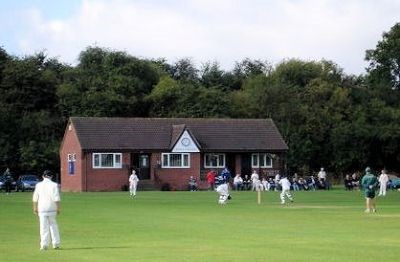 The oldest village club is the Cricket Club which was in existence by 1815.
The oldest village club is the Cricket Club which was in existence by 1815.
The early teams were made up of members of the Astill, Brett, Bexon, Chapman, Holmes and Murden families. Indeed, an account of the Cricket Club, written for its 150th Anniversary celebrations in 1969, states that: "...on several occasions it has been possible for Plumtree to field a representative side composed entirely of Astills".
The cricket ground is on Bradmore Lane next to the railway line. An extension to the current pavilion is planned to provide improved facilities.
The Sick Club
Before the days of the Welfare State, families could experience severe hardship if the breadwinner fell ill and could not work. Many communities tried to overcome this problem by forming Friendly Societies to provide assistance for those members who fell on hard times. One such was the Plumtree Sick Club which was formed in 1830, at a meeting at the Farmers Arms.
Members paid a set sum each month and were entitled to a small payment if they needed it. The club had very strict rules, such as that for membership: "no person shall be admitted a member who is above 30 or under 15, nor who has not had the smallpox and measles, or been vaccinated".
The Sick Club also owned a row of six cottages in Keyworth which brought in a small rent or were used to house needy members.
Men's Club
In 1921 a Men's Club was formed. At the inaugural meeting various gifts were promised - four dozen chairs and lamps from Mrs Burnside, hat & coat pegs from Mr Guy and playing cards, draughts and dominoes from other villagers. The club met in the Burnside Memorial Hall and was run by a committee.
Village Craftsmen
The directories and census returns of the 19th century show that many different craftsmen have worked in the village.
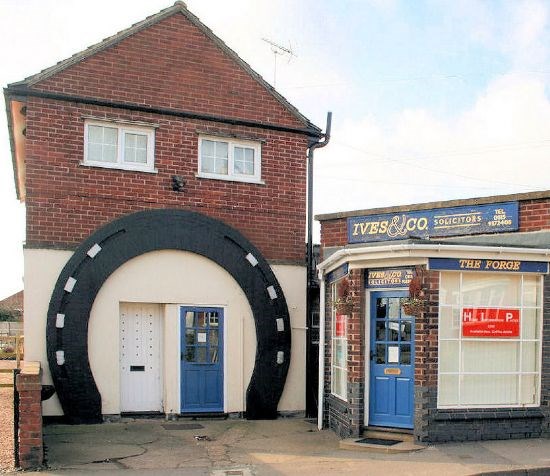 The most obvious relic of a village craftsman is the brick horseshoe over the doorway of what was once the Forge or Smithy (now a Solicitor's office).
The most obvious relic of a village craftsman is the brick horseshoe over the doorway of what was once the Forge or Smithy (now a Solicitor's office).
William Chapman was the blacksmith for much of the 19th century. From around 1916 until it closed in the 1950s James Barnett continued the tradition. As well as shoeing the local horses, the blacksmith would be able to mend farm implements and make other metal tools. The smithy was an exciting place for an observer but involved hard work and great physical strength from the blacksmith.
Another important person in the village was the miller, who also worked as a baker. The mill stood on a small mound down Mill Lane. It was destroyed by fire in 1913. The miller in 1832 was John Hickling and he was succeeded in the 1860s by his son-in-law Samuel Turner. For some time the miller was also landlord of the Griffin Inn.
In a village where agriculture was the main occupation, and at a time when horses were used for most work, another important craftsman was the saddler. The earliest saddler in the directories is William Allcock. From 1868 it is members of the Grice family, first William and later Saville, who were the saddlers. Saville is remembered as having a parrot!
Up until 1900 there was a shoemaker in the village, and for some time there was also a basket maker.
Until they moved out of Plumtree to Bobber's Mill in 2011, the only craftsmen left in the village were the joiners and carpenters at Edson's.
The village shop was a feature in earlier times and there was also a butcher. A Post Office is first mentioned in 1869 and, during the 20th century, it was run by members of the Richmond family.
At one time, after its closure as a blacksmith's, the smithy housed the Forge Stores. Unfortunately this has closed, as has the Post Office and the Farm Shop at Manor Farm. There is now no retail outlet in Plumtree.
Plumtree Women's Institute
Plumtree Women's Institute was founded in 1918. Since that time it has flourished and still plays an important role in the village today.
More recently, members produced a beautiful collage of the village. This was chosen as one of the winners in Nottinghamshire and was put forward to a national competition. The framed collage, which shows in great detail parts of the village and its buildings, is on permanent display in the Burnside Memorial Hall.
Burnside Memorial Hall
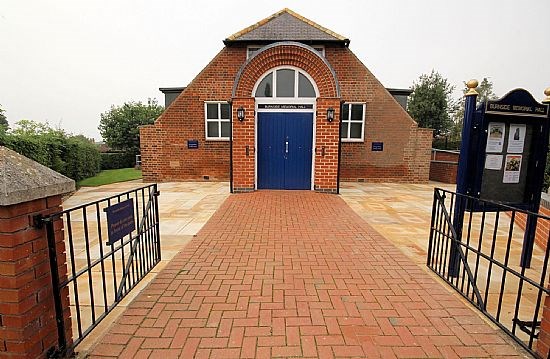 The Burnside Memorial Hall was donated to the parish of Plumtree by Mrs. Alice Mary Burnside, in memory of her husband, William Elliott Burnside "...for the general benefit of the inhabitants". The foundation stone, to the left of the main door, was laid in 1921 and the Hall was opened later that year. The Hall is administered by Trustees.
The Burnside Memorial Hall was donated to the parish of Plumtree by Mrs. Alice Mary Burnside, in memory of her husband, William Elliott Burnside "...for the general benefit of the inhabitants". The foundation stone, to the left of the main door, was laid in 1921 and the Hall was opened later that year. The Hall is administered by Trustees.
The problem of maintenance of such a building has always been of concern to the Trustees. In 1933 electric light was installed; a few years later mains water was connected and in the 1950s a new floor was laid and repairs were carried out in the kitchen. In 1981 the kitchen was rebuilt and more recently a porch has been added and the hall made fully accessible for disabled users.
In 2016, the frontage of the Hall was levelled and landscaped, resulting in much easier disabled access to the grassy area.
The village has been fortunate that, over the years, the Trustees have given much time and expertise to administering the building.
The Burnside Memorial Hall today fulfils a vital role in providing a venue for village events. It is used regularly by Plumtree School and the WI, by the Church, for Parish Council meetings and for bridge and dance classes.
Farming
Over the centuries farming has been of great importance to Plumtree. Although only a small number of people living in the village today work on the farms, it was a very different story in the 19th century. Then, in addition to the farmers and their families, there were ancilliary tradesmen, such as the blacksmith, miller, butcher and carter, as well as many agricultural labourers.
A wide range of farm buildings are still visible today, even though many have been converted into houses. The farms still working are Chestnut Farm on Station Road, and Sycamore Farm on Main Road. Hall Farm on Church Hill and Manor Farm on Church Lane have recently closed. Outside the village there are still farms at Hoe Hill, The Wolds and Flawford. In the village, farm buildings which have been converted belonged to Plumtree House Farm, and Rectory Farm. The farm buildings which belonged to The Griffin farm can also be seen but those which were part of The Farmers Arms have all gone. The old Poplars farmhouse has been renovated but the farm buildings were demolished when the farm moved in 1998.
The surviving farmhouses are all very different. Manor Farm, on Church Lane, is a typical three-storied Georgian farmhouse; there are many of the same style around the villages of Nottinghamshire. In contrast, Chestnut farmhouse on Station Road was rebuilt by William Elliott Burnside in 1906 in the Edwardian style. Sycamore farmhouse on Main Road is a modern building but blends in well with the older buildings in the village.
Over the years different crops and animals have been farmed. At present the livestock is mainly cows, with just one farm rearing some sheep. Crops grown include barley and a silage crop, for animal feed, and wheat and sugar beet.
For a long time cows were a familiar sight crossing Main Road on their way to and from milking. On such a busy road this was clearly inconvenient for the farmers and motorists alike and ceased when Sycamore Farm was built in a more convenient location.
As well as the farm buildings, several cottages in the village were farm workers' homes. Originally all of these were owned by the estate, during the 19th century mainly by the Burnside family.
Parts of the estate were sold during the 20th century including the remaining farms, Town End cottages, two cottages on Old Melton Road and Cottage farmhouse near to the smithy. In 1974 the estate was put up for auction but did not reach the reserve price and was not sold. Later it was bought by a pension company. In 1988 it was put on the market again and was bought by the Duchy of Cornwall.
Village Inns
During the 19th century, there were two inns at Plumtree: The Farmers Arms and The Griffin. Today, only The Griffin remains as a public house; the Farmers Arms is a private residence.
Both of the inns originally had farms attached to them. The farm buildings can still be seen next to The Griffin but most of those which belonged to The Farmers Arms have been demolished and new houses erected on the site.
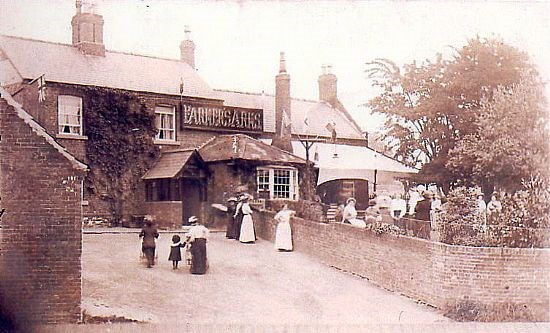
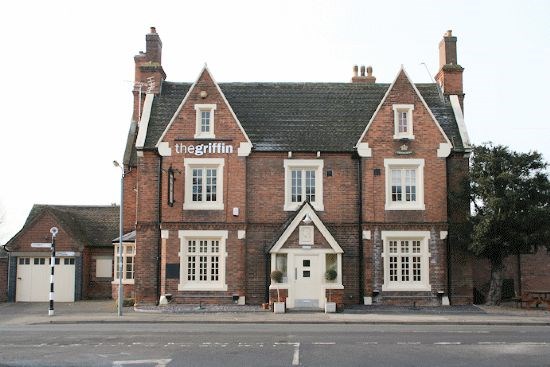
The present Griffin Inn was built in 1843 replacing an earlier public house named The Plough. It was originally part of the Burnside estate. Thomas Crafts was the first landlord and then followed a long period when members of the Turner family were in residence. At the beginning of the 20th century the Holmes family took over.
It was later sold and was bought by a brewery company. As well as providing for the village, it also attracts people from the surrounding area.
At the side of the building is a curious stone which appears on early photographs of the crossroads and was probably a mounting block. On its top surface an Ordnance Survey benchmark points to a small brass rivet. The tip of the rivet is 44.68 metres above sea level.
The Farmers Arms was originally a thatched building, with stables where the coach horses were changed when the Leeds to London Mail coaches passed through the village. There was also a brewhouse where the beer was prepared for customers. In earlier times it also offered accommodation to travellers.
During the First World War it was no longer used as a public house, but was called into service as a prisoner-of-war camp. In 1921 it was sold and divided into two houses one of which was a small farm. More recently much greater changes have occurred. New houses have been built on some of the land and the original house has been altered and modernised. However, the name still exists to show where the inn once stood.
Plumtree In Wartime
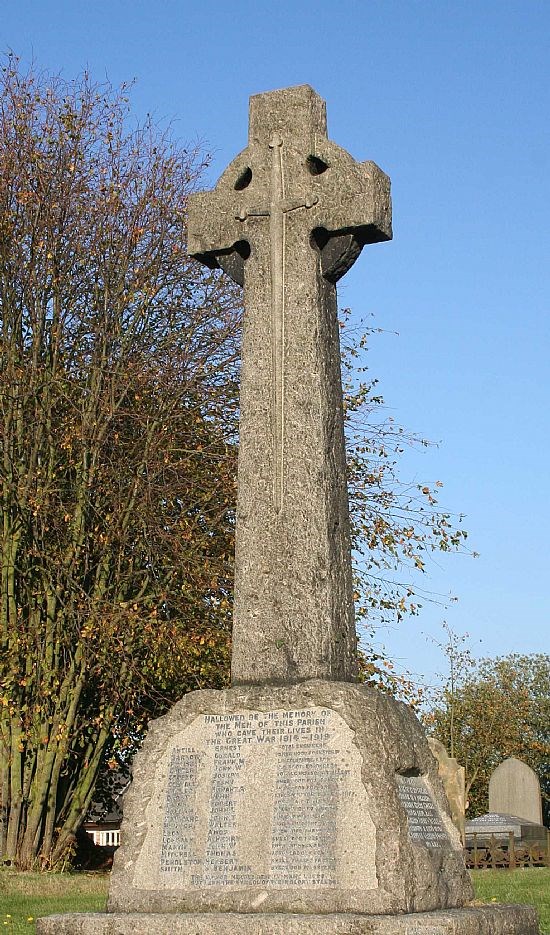 Plumtree War Memorial stands in the churchyard to the west of the church. It was dedicated at a service on Sunday, 9th January 1921 and stands as reminder of the sacrifice made by a community. On the front is a list of the eighteen local men who lost their lives in the First World War; of those listed, five were baptised in Plumtree church.
Plumtree War Memorial stands in the churchyard to the west of the church. It was dedicated at a service on Sunday, 9th January 1921 and stands as reminder of the sacrifice made by a community. On the front is a list of the eighteen local men who lost their lives in the First World War; of those listed, five were baptised in Plumtree church.
On 26th September 1946 the names of four men who lost their lives in the Second World War were added.
In July 2014 George Taylor's name was added to the memorial.
An information sheet in the church provides details about when and where they died and on what other memorials they are recorded.
In the north wall of the church are two stained glass windows which commemorate Montague Bernard Browne, who died in 1916, and Percival Leathley Browne, who died in 1915. These were two sons of the Revd S B Browne (Rector of Plumtree 1883 to 1906). In the churchyard is a memorial to George Taylor who served in the Sherwood Foresters from 1914-1919 but died in 1921.
Plumtree War Memorial - WW1 Casualties Remembered (pdf, 3.6 MB)
One soldier who was born in Plumtree much earlier was Captain William Raynor. He was born in 1795 and baptised in the church. He later joined the Indian Army and in 1857 was serving in Delhi during the First War of Indian Independence. With a small group of companions he helped to defend the ammunition store against rebel attack. He was one of three men who survived the attack all of whom were awarded the Victoria Cross. A brass plaque attached to the noticeboard at the west gate of the churchyard commemorates William Raynor's bravery.
© Sheila Leeds; Fiona and Les Carruthers
